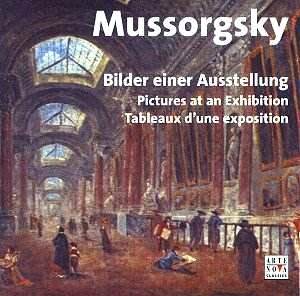 |
Modesty MUSSORGSKY (1839-1881) Crotchet
AmazonUK
AmazonUS |
In either the original piano version or in the many orchestral versions, Mussorgsky's Pictures at an Exhibition has remained towards the top of the popular classics list for many a generation. It is not hard to understand why. The music is unified in concept, varied in delivery, and full of potent and colourful imageries.
The idea of issuing a recording which couples the piano and orchestral versions is hardly new. But it is extremely sensible, allowing the listener to approach the music from either angle, and to make some fascinating comparisons across the individual movements if so inclined. Of the various orchestral versions, that of Maurice Ravel leads the field, to the extent that it is probably played more often than even the piano original. But it is worth remembering that there are several interesting alternatives, taking quite different options, including versions by Vladimir Ashkenazy, Leopold Stokowski and Henry Wood, among others.
Of the two performances paired here, it is Arkady Sevidov playing the piano original which is the more successful. The Arte Nova recording gives a richly ambient acoustic for the music, and the vivid directness of the interpretation is apparent from the opening Promenade, which really sets a tone of anticipation and excitement. Nor does Sevidov lose sight of the interest to be found in each of the pictures, as he continues his tour of the gallery. Vladimir Hartmann's vision of a nutcracker in the shape of a gnome, for example, is strongly characterised and rhythmically powerful, something which can also be said for the representation of the witch Baba Yaga. On the other hand, the dexterity of the finger-work in the lighter but fast-moving Ballet of the Chicks in their Shells is a truly virtuoso affair.
The interpretation of Ravel's orchestral version is exciting too, in its own way, but it is surpassed by many competitors. Again the recording is vivid and direct, and these adjectives can be used well enough to describe much of the playing by the Russian Philharmonic Orchestra under Samuel Friedmann. Neither this orchestra nor the conductor is exactly well known on the international circuit, so it is disappointing that the booklet tells us plenty about Sevidov but nothing about them. On the whole the orchestra doesn't sound very Russian, but that only reflects recent trends in Russian orchestral playing. The major exception to this comes, of all things, from the saxophone in the movement called The Old Castle. The Russian penchant for wide vibrato is here taken to almost absurd levels; nor is the player helped by the close-miking which makes the instrument sound larger than life.
If this is the weakest aspect of the performance, there are many compensations, such as the virtuosity of the trumpet playing in the tale of the rich and poor Jews, Samuel Goldenburg and Schmuyle, and the rapid passage work in The Ballet of the Chicks and The Market Place at Limoges. And with the resplendent and powerful climax of The Great Gate of Kiev, there is still plenty to justify recommending this version at bargain price.
Terry Barfoot